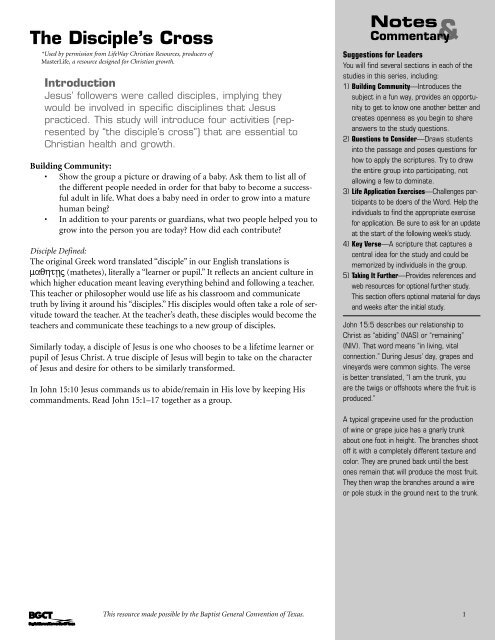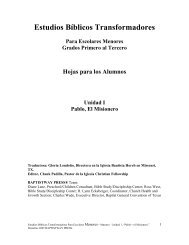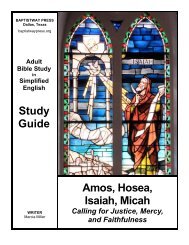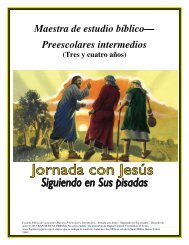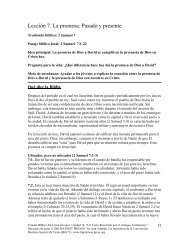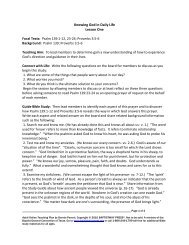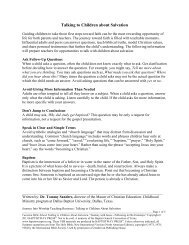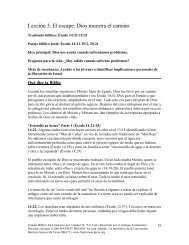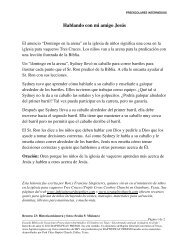The Disciple's Cross - BaptistWay Press
The Disciple's Cross - BaptistWay Press
The Disciple's Cross - BaptistWay Press
Create successful ePaper yourself
Turn your PDF publications into a flip-book with our unique Google optimized e-Paper software.
<strong>The</strong> Disciple’s <strong>Cross</strong><br />
*Used by permission from LifeWay Christian Resources, producers of<br />
MasterLife, a resource designed for Christian growth.<br />
Introduction<br />
Jesus’ followers were called disciples, implying they<br />
would be involved in specific disciplines that Jesus<br />
practiced. This study will introduce four activities (represented<br />
by “the disciple’s cross”) that are essential to<br />
Christian health and growth.<br />
Building Community:<br />
• Show the group a picture or drawing of a baby. Ask them to list all of<br />
the different people needed in order for that baby to become a successful<br />
adult in life. What does a baby need in order to grow into a mature<br />
human being?<br />
• In addition to your parents or guardians, what two people helped you to<br />
grow into the person you are today? How did each contribute?<br />
Disciple Defined:<br />
<strong>The</strong> original Greek word translated “disciple” in our English translations is<br />
maqhtVj (mathetes), literally a “learner or pupil.” It reflects an ancient culture in<br />
which higher education meant leaving everything behind and following a teacher.<br />
This teacher or philosopher would use life as his classroom and communicate<br />
truth by living it around his “disciples.” His disciples would often take a role of servitude<br />
toward the teacher. At the teacher’s death, these disciples would become the<br />
teachers and communicate these teachings to a new group of disciples.<br />
Similarly today, a disciple of Jesus is one who chooses to be a lifetime learner or<br />
pupil of Jesus Christ. A true disciple of Jesus will begin to take on the character<br />
of Jesus and desire for others to be similarly transformed.<br />
In John 15:10 Jesus commands us to abide/remain in His love by keeping His<br />
commandments. Read John 15:1–17 together as a group.<br />
Notes<br />
Commentary &<br />
Suggestions for Leaders<br />
You will find several sections in each of the<br />
studies in this series, including:<br />
1) Building Community—Introduces the<br />
subject in a fun way, provides an opportunity<br />
to get to know one another better and<br />
creates openness as you begin to share<br />
answers to the study questions.<br />
2) Questions to Consider—Draws students<br />
into the passage and poses questions for<br />
how to apply the scriptures. Try to draw<br />
the entire group into participating, not<br />
allowing a few to dominate.<br />
3) Life Application Exercises—Challenges participants<br />
to be doers of the Word. Help the<br />
individuals to find the appropriate exercise<br />
for application. Be sure to ask for an update<br />
at the start of the following week’s study.<br />
4) Key Verse—A scripture that captures a<br />
central idea for the study and could be<br />
memorized by individuals in the group.<br />
5) Taking It Further—Provides references and<br />
web resources for optional further study.<br />
This section offers optional material for days<br />
and weeks after the initial study.<br />
John 15:5 describes our relationship to<br />
Christ as “abiding” (NAS) or “remaining”<br />
(NIV). That word means “in living, vital<br />
connection.” During Jesus’ day, grapes and<br />
vineyards were common sights. <strong>The</strong> verse<br />
is better translated, “I am the trunk, you<br />
are the twigs or offshoots where the fruit is<br />
produced.”<br />
A typical grapevine used for the production<br />
of wine or grape juice has a gnarly trunk<br />
about one foot in height. <strong>The</strong> branches shoot<br />
off it with a completely different texture and<br />
color. <strong>The</strong>y are pruned back until the best<br />
ones remain that will produce the most fruit.<br />
<strong>The</strong>y then wrap the branches around a wire<br />
or pole stuck in the ground next to the trunk.<br />
This resource made possible by the Baptist General Convention of Texas. 1
<strong>The</strong> Disciple’s <strong>Cross</strong><br />
Notes<br />
Commentary &<br />
Ministry of<br />
Worship or<br />
Intercession<br />
Luke 9:23<br />
Deny<br />
Take <strong>Cross</strong><br />
Follow<br />
Suggestion to Leaders<br />
Since there are several paragraphs<br />
that follow to describe the elements of<br />
“the Disciple’s <strong>Cross</strong>,” it may be helpful<br />
to ask each member in the group to<br />
read a paragraph so that everyone will<br />
be involved in getting the background<br />
information.<br />
John 15:7<br />
MINISTRY OF SERVICE; John 15:13<br />
Ministry<br />
of<br />
Evangelism<br />
WITNESS<br />
John 15:8<br />
CHRIST<br />
John 15:5<br />
FELLOWSHIP<br />
John 13:34-35<br />
Ministry<br />
of<br />
Nurture<br />
John 8:31-32<br />
Ministry of<br />
Teaching and Preaching<br />
When Jesus called people to become His disciples, He said, “If anyone would<br />
come after me, he must deny himself and take up his cross daily and follow me”<br />
(Luke 9:23). Here, Jesus both issues an invitation (the call to follow Him) and<br />
gives instruction (how to follow).<br />
To “deny myself” on a practical level often involves saying no to my agenda and<br />
yes to His. To “take up my cross” means offering God maximum obedience just<br />
as Jesus modeled in His own obedience in relation to the cross (see Philippians<br />
2:8). To “follow Jesus” means to take on the overall pattern of the life Jesus lived.<br />
His habits and practices regarding the way He related to God and others begin to<br />
shape our lives.<br />
Like the cross, the spiritual disciplines of the Christ-life (another word for discipleship)<br />
have vertical (between God and us) and horizontal (between others<br />
and us) dimensions.<br />
This resource made possible by the Baptist General Convention of Texas. 2
<strong>The</strong> Disciple’s <strong>Cross</strong><br />
• Vertical<br />
<strong>The</strong> vertical aspect of the cross represents how we nurture and strengthen<br />
our relationship with God. Communication comes from God to us<br />
primarily through our interactions with the Bible, God’s Word, where we<br />
come to know God, God’s will and God’s ways. We communicate with<br />
God through prayer in its various forms such as praise, confession, petition,<br />
intercession and quiet listening. John 15:7 gives insight into how<br />
powerful this connection with God through Scripture and prayer can<br />
be: “If you remain in me and my words remain in you, ask whatever you<br />
wish, and it will be given you.”<br />
Notes<br />
Commentary &<br />
• Horizontal<br />
<strong>The</strong> other direction of the Christian life is horizontal, involving our relationships<br />
with people. We relate to those who follow Jesus through fellowship.<br />
John 13:34–35 is a direct command from Jesus to love people as<br />
He loves us. We relate to unbelievers through witness and service. Jesus<br />
says that we honor Him when we produce “much fruit” that “remains”<br />
John 15:8, 16. In other words, when we reproduce the life of Christ. In<br />
an unbeliever, it is called evangelism (witness). In a Christian, it is called<br />
discipleship, a process that includes Scripture, prayer, fellowship with<br />
believers, and ministry to others.<br />
Questions to Consider:<br />
Refer back to John 15:1–17 and answer the following questions:<br />
1. What principle(s) of fruit bearing is/are suggested in verses 1–4? How<br />
would you encourage a new believer to “abide in Christ?”<br />
2. What is Jesus’ promise to those who abide in His word (v.7)?<br />
3. How does v.8 suggest that God is glorified?<br />
4. Why might disciples of Jesus be unfruitful (vv. 7–8)?<br />
5. Are you more likely to see the immediate “pain” in the pruning process<br />
and try to resist? Or, do you look at the potential benefit of being<br />
pruned?<br />
6. As the Gardener, what do you think Jesus wants to do to improve your<br />
fruitfulness?<br />
7. How do you think the Father is currently pruning your life?<br />
8. If you were an apple tree, how would you describe the fruit your life is<br />
bearing these days? A sweet Golden Delicious or a tart Granny Smith?<br />
9. According to verse 10, how can believers make sure they abide in Jesus’<br />
love?<br />
10. What role(s) have you/can you play in helping a new Christian grow<br />
spiritual fruit?<br />
11. How can you grow in God’s Word on a consistent basis next week?<br />
SUGGESTION FOR STUDY LEADER: You will<br />
want to preview the questions below to<br />
ensure that you have time to cover the most<br />
important ones and allow time for group discussion.<br />
(<strong>The</strong>re are probably more questions<br />
than you will have time to cover in an hour<br />
study.) Mark questions that you want to cover<br />
and keep the group moving through the study.<br />
Pray that God will grant wisdom in knowing<br />
when to move to another question.<br />
This resource made possible by the Baptist General Convention of Texas. 3
<strong>The</strong> Disciple’s <strong>Cross</strong><br />
Life Application Exercises: (Select one or more)<br />
If you were to draw a cross proportionally to the way the four disciplines are<br />
presently represented in your life, which part of the cross would be the “shortest?”<br />
(This would represent the most neglected spiritual discipline.) In light of<br />
your answer, choose one of the following exercises to deepen your relationship<br />
with Christ:<br />
Notes<br />
Commentary &<br />
1. Spend 10 minutes/day in Scripture, moving a marker to keep your place<br />
in the text.<br />
2. Go early and stay late at church; help to make someone feel more comfortable,<br />
greet and introduce others. Be intentional about inviting someone<br />
other than a friend to lunch; share how others can pray for you.<br />
3. Write a prayer or spend a few minutes each day in quiet reflection.<br />
4. Pray through these Psalms: Ps. 13 (emphasis on distress), Ps. 15 (emphasis<br />
on character of those who come before God), Ps. 19 (emphasis on the<br />
glory of God in nature and the greatness of His Word), Ps. 51 (emphasis<br />
on repentance and renewal), Ps. 103 (emphasis on praise for God’s blessings<br />
and goodness).<br />
5. Minister to or serve another person anonymously.<br />
6. Spend an hour this week with non-believers, looking for an opportunity<br />
to share spiritual truth.<br />
7. Pray that God will direct you to a person that you can disciple (a believer<br />
or non-believer).<br />
Key Verse:<br />
“I am the vine, you are the branches; he who abides in me and I in him, he bears<br />
much fruit; for apart from Me you can do nothing.” (John 15:5 NASB)<br />
Taking It Further:<br />
<strong>The</strong> Disciple’s <strong>Cross</strong>, Masterlife Book 1, by Avery Willis, Lifeway <strong>Press</strong>, 1996 is<br />
a six-week workbook on this same topic.<br />
Spiritual Disciplines of the Christian Life, by Don Whitney, IVP, 1991 is an<br />
excellent practical guide to transforming this info from lesson to lifestyle.<br />
Discipleship Essentials, by Greg Ogden, IVP, 1998 is a very helpful resource.<br />
Online resources:<br />
www.gospelcom.net/eword/search/<br />
Access any Bible chapter, passage, word or phrase in your choice of translations.<br />
This resource made possible by the Baptist General Convention of Texas. 4


